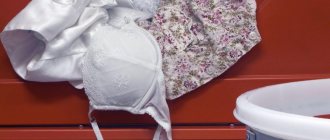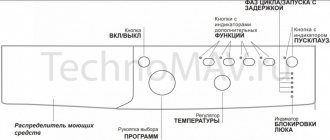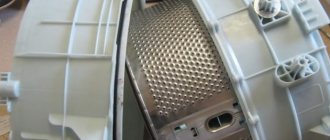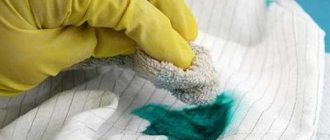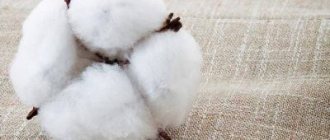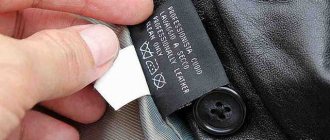A common problem that everyone has encountered at least once is puffs that appear on clothes after washing. Gentle washing will help preserve your items. If old models of washing machines were, alas, deprived of such a function, modern ones are necessarily equipped with it. Each one has either an inscription or a “gentle wash” symbol. Let's tell you more about the advantages of this mode.
What is and features of delicate washing
This concept occurs in two cases:
- when working with a washing machine, we are talking about the control lever;
- when studying a clothing label, it refers to the badge.
In both options, this means the washing mode. You can select it with a button when using an automatic machine or by setting the settings manually. Work with things is carried out according to one scenario. It is formed from the peculiarities of handling “fragile” tissues.
Delicate material loses its shape and color during standard cleaning. The time it remains in the drum in delicate mode is reduced to an hour. His movements become smooth. The minimum water heating is set and its quantity increases. Spin is set to minimum or disabled. The number of revolutions should not exceed 800. Drying and ironing should be turned off.
When manually spinning, wet items move into the basin. When the liquid has drained, tie it in a towel, wring it out and lay it out on a flat surface.
This will reduce the degree of mechanical impact on the fabric fibers and ensure gentle care.
This is interesting: Capitonium fabric: what kind of fabric is it in terms of composition, types, use
Preparatory stage
Before you begin, you need to properly prepare things:
- The clothes are turned inside out.
- Since the bottom of the product and the sleeves can stretch out during wet processing, they should be protected by threading a needle or any other strong and non-fading thread and stitching the problem areas along the edge with wide stitches. Pair the thread only after the product has completely dried.
- Are your clothes stained or heavily soiled? This means that before washing, they soak it - pour cool water into a basin, generously soap the problem areas, and leave for 20 minutes.
- Before washing knitted items, you should carefully study their label: items made from natural fabrics are washed in water at a temperature no higher than 40-50°C, those made from synthetic fabrics - up to 40°C. Do not wash with hot water, as high temperatures may cause the product to shrink.
How long does it last?
Depending on the manufacturer, the time period for washing in a machine can be determined differently. Mostly 50-90 minutes, but there are also manufacturers that allow you to do the wash in half an hour.
The time period may vary among different manufacturers.
When washing by hand, do not forget to observe the temperature regime, it is important for caring for things. In cases with severe dirt or old stains, it is better to contact a dry cleaner for the help of professionals.
Selecting a detergent
It is not recommended to use regular washing powder for washing knitwear - it does not rinse well, and delicate fabric may become damaged after contact with it. Several means are acceptable:
- Soap solution. Laundry soap is rubbed on a fine grater and the shavings are dissolved in water.
- Gel for washing delicate fabrics.
- Shampoo. If you don’t have a special product at hand, you can use any hair shampoo.
- Hard water can deteriorate the appearance of a knitted product; to soften it, use baking soda - about 1 teaspoon will be needed for a medium-sized basin.
- Do not use bleach for knitwear. If it is necessary to make the item white, after washing it, rinse it in water with the addition of a small amount of hydrogen peroxide. A couple of tablespoons of salt or vinegar will help return faded fabric to its rich color - they are dissolved in a bowl of water when rinsing.
When it's needed
We use delicate or gentle washing when the fabric from which the clothes are made requires it. Washing in this mode avoids shedding. Does not harm fine fibers. With it you don’t have to worry that the color of the item will lose its brightness. Of course, all these factors are possible subject to certain rules for the washing process.
The delicate mode is used for certain fabrics.
Features of delicate washing
Delicate wash is a special mode for washing fabrics that need careful handling, characterized by a reduced number of revolutions without spinning in a centrifuge and an increased water level. It allows you to extend the life of your things.
What does the delicate wash cycle include?
- A large amount of water in the tank is necessary to minimize mechanical stress on the fabric.
- Low temperature up to 40°C reduces the shedding of linen and prevents it from staining.
- Smooth and slow movements of the drum will not cause harm to tissues.
- There is no spinning of clothes on washing machines; sometimes it is activated on some models, but with speed reduced several times.
- There is no drying function.
But it's not that simple. Equipment manufacturers understand the term “delicate washing” differently. Some models are gentle only on wool and silk , while on others this mode is intended exclusively for cotton. In order not to make a mistake and not to put your things at risk, you need to study the instructions indicating the necessary parameters.
What fabrics are suitable for delicate washing?
A label on the back of the garment will indicate whether the item needs to be treated with care. In its absence, there are rules for which fabrics a special regime applies:
- artificial: viscose, elastane, lycra, polyester;
- natural: wool and silk.
In addition, if the fabric is rich in color and has many details in the form of buttons, ruffles , then it is always washed in a gentle mode. This also includes lace products.
What if there is no such regime?
It happens that there is no delicate wash on the program selection panel in the washing machine. This happens at several points.
The mode is considered redundant, since the machine contains additional programs, in addition to the standard ones, designed for washing wool, silk, and delicate fabrics. It is believed that this is enough.- According to manufacturers, hand washing is similar to delicate washing. Therefore, if the first mode is present in the machine, then it presupposes a careful attitude towards things.
If such a program is still not available, then simple steps are taken independently for delicate washing .
- The temperature does not exceed 40 o C.
- Spin mode is disabled.
- Washing takes place in special bags - meshes to prevent deformation of things.
What means can be used?
For items that require care and protection during washing, special detergents are used. In order not to get confused in the variety of powders and conditioners, those that have a special mark on how to treat things with care are selected. Universal products are excluded, and the choice is made in favor of those that do not contain aggressive components, phosphates, chlorine, which damage tissue.
For gentle washing, it is best to choose liquid detergents that dissolve in water and are completely washed out of fabrics. They do not cause allergies, remove stains and wash well. Things retain their original color. Thanks to the presence of lanolin and other softening components, the product will not lose its shape. The product is biodegradable without harming nature.
Let's be honest about the regime
It is designed for cleaning items made from thin or wrinkled fabrics. These include silk, viscose, linen - as well as wool, microfiber and many other materials. Improper washing of clothes made from such fabrics is fraught with a sad outcome: puffs, pilling, stains - thus, shirts and sweaters will be hopelessly damaged. The gentle wash function is designed to avoid these problems.
It is not difficult to understand whether an item requires such a regime when washing: each item has a label attached to it, which contains a recommendation on the type of cleaning. The delicate wash icon on the label looks like a drawing of a bowl of water with two horizontal lines underneath it. Some manufacturers put numbers in the basin - 30 or 40. They indicate the temperature at which it is better to wash this item (at 30 or 40 degrees, respectively).
Differences between delicate washing and other modes:
- using more water (thus the mechanical impact on clothing becomes gentler);
- low temperature (this reduces the shedding of things, they will not recolor each other during washing);
- slow and smooth movements of the drum (this ensures that the item does not tear/roll and the decorations remain in place);
- delicate spin (with fewer revolutions - 600-800 per minute, which does not damage clothes).
What things require gentle care?
Delicate washing is the gentle cleaning of items from dirt at low drum speeds and at low temperatures. The mode is intended for thin and stretchable material, which is easily damaged during operation of the machine, and especially during spinning. If you run a standard program, capricious things may lose their shape and volume. The bright colors will fade, and pills and puffs will appear on the clothes.
Delicate fabrics are materials made from “fragile” fibers that require special care. It must be handled with care, otherwise distortion, thread breakage, or shrinkage of the product may occur.
Delicate fabrics include natural silk and satin, fine wool, cambric, chiffon, lace. Some manufacturers indicate that artificial fibers - organza, polyester, viscose, elastane - should be washed in a special mode. Clothes made from cashmere, knitwear, microfiber, as well as products from some new generation fabrics require careful handling.
Advice
To determine in which mode you should wash your favorite item, pay attention to the label. It indicates the maximum water temperature at which the fibers of the fabric will not lose their original appearance. If hand wash is indicated, most likely the item is made of capricious material that can be easily damaged.
This is interesting: Capron. Nylon fabric: properties, application, technical, characteristics, disadvantages
Nuances that are important to know
Surely, you are interested in the question - what washing conditions should be followed in order for the delicate mode to wash truly delicately, but effectively? There are few rules:
- separate colored items from light ones;
- for washing it is better to use a specialized liquid detergent and a small amount of softener;
- Pre-soak heavy stains with stain remover for delicate fabrics;
- refrain from pre-soaking;
- some things, such as linen, should be loaded into the washing machine only in special covers or bags;
- do not leave things in the machine after finishing washing;
- Some things that are prone to stretching are best not hung, but rather laid out to dry.
Drying and ironing
Knitted items are dried exclusively in a horizontal position. When the excess water has drained, the item is laid out on a special mesh dryer, carefully straightening it out. Another method is to use a towel laid out on the table. In this case, it will have to be periodically replaced with a fresh one, and the item will have to be turned over to the other side.
Important! During drying, clothing should not be exposed to direct sunlight.
If creases remain on the knitwear after washing, you can iron it. However, you need to remember that products made from thick threads or those with a relief pattern should not be ironed - the knitting will become flat.
The iron is set to minimum heat. Place an ironing iron - a piece of clean cotton fabric - on top of the item laid out on the ironing board; iron only through it. Do not put too much pressure on the device; movements should be light.
If the ironed item turns out to be wrinkled after storing in the closet, you can lightly moisten it with clean water from a spray bottle, lay it out on the table, straighten it thoroughly and leave it for a while. After the moisture has completely evaporated, the folds in the fabric will disappear.
This may be useful: How to wash cotton.
How to iron and dry clothes after washing
Wäschetrockner, BaWa 004
It is worth noting that gentle washing alone is not enough to preserve the original appearance of the products. It is recommended to dry and iron clothes properly.
Tips for drying delicate materials:
- if you did not use a spinner, hang things on hangers over the bathtub and let the water drain;
- Never dry wet items on a line in a bent state or attach them with clothespins;
- either hang the product on hangers or lay it out on a horizontal, preferably mesh, surface;
- to speed up the process, do not place clothes on a radiator or other sources of artificial heat;
- Do not leave light-colored laundry to dry in the sun; try to hang the items in the shade;
- Place the guipure and lace on a flat horizontal surface and cover with absorbent material.
Tips for ironing delicate fabrics:
- for processing, use a high-quality iron with a clean and smooth sole;
- first, try ironing an inconspicuous area of the material with a slightly warm iron, see if the treated area is deformed;
- iron wool at a maximum of 180 degrees only through slightly damp cotton fabric;
- Either do not iron synthetics at all, or set the iron temperature to 110 to 130 degrees, and process only through cotton fabric;
- Iron the organza through a thick sheet of paper at a temperature of 100 to 110 degrees;
- iron silk clothes from the inside out slightly damp, setting the iron temperature to a maximum of 160 degrees; if the material is dry, to prevent streaks from appearing, do not spray the fabric, but moisten it by wrapping it in a damp towel;
- It is better not to iron velvet items, but to treat them with steam from a steam generator or by hanging the item over a bathtub with hot water;
- products made of nylon and elastane cannot be ironed;
If you are unsure of the type and origin of the material, look at the label on the product. The crossed out iron icon means that ironing clothes is prohibited, and the number of dots in the center indicates the degree of heating of the device.
How is washing done in gentle mode?
The delicate wash mode implies the following nuances.
- Washing stains occurs at low speeds - the washing machine drum rotates more slowly than usual.
- When using the program, more water is consumed: this is necessary in order to protect the fabric from mechanical damage and friction.
- Cleaning of things is carried out at a low temperature, usually it is within 30-40 degrees.
- Spinning is carried out at low speeds - 400-600, maximum - 800 revolutions, and in some models this function is disabled. You will have to manually wring out the clothes.
- The program has a shorter duration, the washing time is reduced to 1-1.5 hours.
In some washing machines, instead of the delicate wash mode, other programs are indicated - “wool”, “silk”, “hand wash”. Variations may vary, so please read the instructions for the device. In it, the manufacturer must indicate which of the available functions is suitable for which materials.
How many degrees?
For many fabrics - synthetics, wool, silk, hot water is strictly contraindicated: they can be washed in a delicate cycle or select programs of the same name. In some machines, the gentle washing process involves heating the water to 30 degrees, in others - up to 40 degrees. Thanks to such temperatures, delicate fabrics retain the brightness of their colors, do not fade, and do not wear out.
Function description
Delicate washing is nothing more than a mode of gently washing things in an automatic machine. This means that during the wash a special mode will be set with low drum speeds at a minimum water temperature. In this case, washing off dirt and stains occurs with a large volume of water. This helps protect the fabric from mechanical damage and friction.
The water temperature in this case averages 30 degrees, which is different from most other programs. At low temperatures, fading of textiles is excluded, and therefore the brightness of things will not change. Compared to other modes of the device, this wash lasts much less. The number of revolutions per minute ranges from 400 to 600, the movement of the drum is smooth.
This mode is characterized by the absence of drying. In another way, delicate washing is called manual or gentle. It is not intended for all things and has an icon depicting a container with water and a temperature of 30 degrees. However, there is no single designation, since the icons of different manufacturers may vary.
Somewhere, "Eco", "Silk". Some icons have their own designations. For example, this could be an image of a basin with water, a temperature number and horizontal lines below the bottom of the depicted container. Less commonly, the delicate wash icon on dashboards depicts a bowl of water and a hand, a feather, a butterfly, a flower, or a ball of wool.
How is it designated?
What the icon of the described mode looks like depends on the brand of the washing machine. For models from Candy, LG, Indesit, Samsung, the function is signed in Russian or indicated by an intuitive symbol. Here are some examples:
- Ariston. Two options - a flower and a basin with a hand lowered into it.
- Bosch. A dress with a butterfly on it.
- Electrolux. Basin with hand (handmade), butterfly (fine fabric) and flower (delicate).
- Zanussi. Basin with hand (manual) - two options, flower (delicate) - also two options.
Rules for caring for natural fabrics: how to wash, dry, iron?
Important: Natural fabrics include linen, cotton, silk, and wool. The group of natural fabrics also includes velvet, satin, terry, calico, etc. Natural fabrics are made from environmentally friendly materials, which is why they are so in demand.
The price of natural fabrics is higher than the cost of synthetic ones. And this is completely justified. Natural fabrics are breathable, hypoallergenic, and pleasant to the touch.
Cotton
This is a lightweight fabric. Most children's clothing is made from cotton because it is the most suitable fabric. Cotton is soft, delicate, breathable, hypoallergenic. Cotton is most suitable for making lightweight summer clothing.
Cotton in its pure form shrinks and wrinkles, so in most cases it is processed using special methods. This makes the fabric more practical. Caring for cotton depends on how the fabric is treated, but there are general rules for caring for this fabric.
- Recommended washing temperature is 40°. But for very dirty things you can set the temperature to 60-95°.
- Machine drying is contraindicated; drying is allowed only in a straightened form; things must be hung wet.
- Cotton should be ironed when it is still damp. Or with the steam function on the iron.
- Iron temperature no more than 200°.
- Cotton should not be washed together with synthetics, otherwise the fabric may wrinkle.
- Cotton can quickly become covered with pellets; to do this, it should be subjected to minimal friction with foreign objects. For example, do not wear jewelry or carry a bag on your hip.
- Do not use bleach for washing colored cotton items.
- Thin cotton items are best washed by hand.
Cotton products
Velvet
Important: The fabric is rightfully considered “royal”. She's so beautiful and capricious. The fabric has many advantages - it is hypoallergenic, breathable, looks great, and with proper care will last a long time.
Basic rules of care:
- Velvet cannot be washed in a washing machine, only by hand or dry clean.
- When washing, do not rub the item intensively, otherwise the material will deteriorate.
- Instead of abrasive washing powder, use liquid washing gel.
- You can get rid of moisture with a terry towel. To do this, place the velvet product on a towel and roll it up. The procedure must be repeated several times, changing the towel.
- Velvet should be dried with its pile up in a horizontal position.
- You cannot store velvet folded, otherwise creases will appear. Only in a vertical unfolded position.
Velvet
Velours
The fabric is similar to velvet, but differs in softness and long pile. On one side, velor has a smooth shiny surface, on the other - soft pile.
Important: The advantage of velor is that it does not wrinkle, is wear-resistant, soft, and retains heat well. Cons - the fabric collects debris, the pile can break.
Velor is not particularly picky to care for:
- Wash by hand and machine at 30°.
- You should wring it out lightly, do not twist the product too much.
- Velor should be dried on a horizontal surface away from the sun.
- A velor product should be ironed inside out, without pressing the iron too hard.
- After ironing, you need to steam the product, this will allow the pile to rise.
- Upholstery on velor furniture should be cleaned dry. But if there is contamination, it is worth treating it with a soap solution.
Velor products
Silk
If you have items made from natural silk in your wardrobe, you can be considered a person of good income and taste.
Important: Natural silk is a valuable fabric, the production of which is very labor-intensive. Hence the high cost of fabric.
Natural high-quality wool wrinkles little, regulates temperature, and quickly evaporates moisture. Silk can be light or thick.
Basic rules for caring for silk:
- Silk fades, wash this fabric exclusively by hand at 30°.
- Rubbing or twisting silk fabric is unacceptable.
- Choose liquid laundry detergent.
- You need to rinse silk products the first time in warm water, the second time in cold water.
- A small amount of vinegar will brighten the fabric. Simply add vinegar to your rinse water.
- Wrap a damp silk item in a cloth and wring it out lightly.
- You can dry silk on a horizontal surface or in a vertical position.
- The main condition for drying is away from heating devices and the sun.
- Silk should be ironed from the wrong side while the fabric is slightly damp.
- Set the iron to Silk mode.
- The chesucha variety of silk can only be ironed when dried.
- It is unacceptable to spray water from the iron onto the product, otherwise streaks will remain.
- Traces of sweat on a silk product are removed with an alcohol solution.
Silk fabric
Wool
Wool is a natural warm fabric. Products made from wool hardly wrinkle, and if they do, just hang them up and the product will soon straighten out.
Any foreign odors quickly disappear from this fabric. Wool retains heat well, but dries slowly.
Basic rules for grooming:
- It is better to wash by hand with plenty of water.
- Washing is also possible in a washing machine, but at a temperature not exceeding 30° on the Wool mode.
- The product cannot be twisted. You can remove moisture by wrapping the product in terry cloth.
- Drying woolen items on radiators is prohibited.
- Drying away from sunlight is recommended.
- You can iron wool at a low iron temperature and always through a damp cloth.
Wool products
Cashmere
Important: Noble fabric that looks luxurious. Natural cashmere is made from the underfur of a mountain goat. Cashmere retains heat well and, with proper care, is durable.
The disadvantages include the cost of natural cashmere. Not everyone can afford such an expensive product.
The rules of care are simple, but they must be followed. Otherwise, cashmere will quickly lose its appearance.
- Cashmere is not intended for frequent wear. Products should hang quietly in the closet for some time.
- If the fabric is wrinkled or creases appear, you need to hang it on hangers. After a few days, the creases will disappear and the fabric will smooth out on its own.
- Wash cashmere in cold or slightly warm water exclusively by hand.
- Rough pressing is prohibited.
- Drying in an unfolded horizontal or vertical position.
- You can iron cashmere with steam without touching the iron to the fabric.
- If pellets appear, remove them with a special machine or manually.
- Cashmere can fade in the sun; do not expose the fabric to direct sunlight.
Cashmere
Linen
Strong, durable fabric. Linen is suitable for making summer clothes, as the fabric is hygroscopic, lightweight, and breathable. Napkins, tablecloths, and curtains are also made from flax.
The disadvantages of the fabric include stiffness and roughness. And also that the fabric wrinkles and shrinks a lot.
Basic rules for caring for linen products:
- The product can be soaked before washing.
- Can be washed at high temperature in a washing machine.
- Linen should be dried in a well-ventilated area or in the open air.
- Immediately after drying, the product must be removed and ironed.
- Linen must be ironed through a damp cloth or with a spray.
- The iron temperature may be high.
- Colored linen fabrics must be washed with powder without bleach; otherwise, there are no special requirements for the powder.
- Linen products often shrink after washing and cannot be dried in special devices.
Linen
When buying a product made from natural expensive fabric, it is important not to get a fake at a high cost. Therefore, we invite you to watch a video on how to distinguish natural fabrics from fakes.
Types of delicate fabrics.
Natural:
- Rabbit wool (angora), goat wool (mohair and cashmere), sheep wool.
- Silk.
